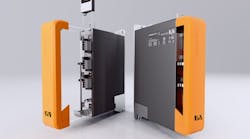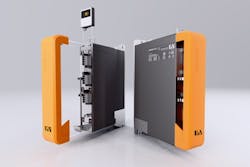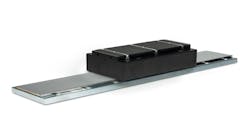Call 770/772-0400, email [email protected], or browse to www.br-automation.com.
Part of our Product Exclusive series —
Built for the future and scalable with improved electronics, the new B&R ACOPOS P3 three-axis drive is designed to be faster, more capable and the most efficient servo drive with integrated safety functions available on the market. Even those not taking advantage of the scalability and performance improvements can take advantage of the power density and virtual sensor technology to reduce the size and cost of the control system.
Innovation is where B&R really shines. "B&R is still privately owned, so it can stay focused on what it does well, which is automation hardware and software," says Corey Morton, director of technology solutions at B&R Industrial Automation. "B&R as a company takes about 20% of revenue and invests it in R&D. The Solutions team in the United States spends about 50% of our time on R&D-related activities and about 50% on sales and application support."
Much of the new technology is embedded in this three-axis drive. "It has scalability," says Morton. "This applies not only to the new B&R ACOPOS P3, drive but to the B&R offering across the board. B&R delivers product that can scale to meet the needs of our customers."
The P3 is scalable from a hardware and software perspective. The new unit can handle up to three-axis in the same size housing as most single-axis units and is available in standard and safeMotion configurations providing enough options for a wide range of applications.
Also read: Motion control joins the efficiency revolution
The drive works well for precision and complex applications and can be expanded to include additional features such as safety and external filters. "Since the basic servo application may not need to meet CE/EMC requirements, the filter is no longer built in, but it can be added later," says Morton. "The scalability from a hardware side enables connecting two three-axis units by tying in the dc busses and daisy chaining the line power for easy expansion."
Smaller with bigger performance
With the improved electronics and heat removal, along with one-, two- or three-axis drive, it covers a power spectrum ranging from 0.6 to 24 kW, or 1.2 to 48 A. The housing of the three-axis drive is as small as a conventional one-axis drive, making it possible to reduce the amount of space required in the control cabinet by almost 70%.
Combining three drives into one unit provides a much smaller package all around. "Not only is less panel space used by the drive, there is less filter and fuse or circuit-breaker space needed, resulting in a smaller control cabinet," says Morton. "Single cable motor technology also simplifies installation, and the P3 has been optimized for it, as the digital encoder interface is built-in."
With an almost 70% reduction in size, heat dissipation was the big battle, notes Morton. "But advancements in transistor technology and processor technology has ensured future scalability," he says. "The transistor devices have gotten smaller and smaller with faster switching time, which is good for control, and a single processor is now controlling three axes."
The drive is one of the fastest on the market. "The older drives ran at a 400 µs update rate. The sampling time now is just 50 µs for current, speed and position control," says Morton. "This helps with higher-performance machines and processes such as print applications. With faster algorithms, you can solve application issues."
The faster processors and related fast sample rate enable virtual sensor technology. "This technology enables running a servo motor without an encoder," says Morton. "It's open loop with the drive controlling servo motor commutation without encoder feedback. It's similar to a variable frequency drive running open loop. The encoder is eliminated, but very good position control is maintained."
This virtual sensor technology works well in repeatable response applications where two mass oscillators are present with a servo and drive train and a roll. In the past, it was often necessary to look at the position of the load (roll) and motor due to twisting under acceleration, for example. With the virtual sensor, an open-loop method, with a loop-closing algorithm, determines the position in these repeatable response applications.
Safety integration
The drives all have safe torque hardwire inputs. Safety functions in accordance with SIL3/PLe can be integrated as needed. These safe motion functions, such as safely limited torque (SLT) and remnant safe position (RSP) and many others are based on openSafety protocol.
The P3 is specifically intended to be used on Ethernet Powerlink connected to a B&R controller. "Controlled as part of a B&R system, people reap the best benefit as a motion system, which includes B&R controllers, Power Panel and drives to meet and establish a level of performance," says Morton.
This new drive integrates well with the B&R Power Panel, which is a PLC with a C70 HMI display. "Whether standard discrete equipment, CNC machine or robotics application, it's the same hardware,” says Morton. "All of B&R hardware is suitable for a wide range of applications. Just add configuration, not programming, as new software development components are configured graphically for accelerated development of a motion control system."







